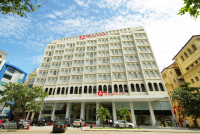Shehani Nuwarna Review of Colombo Rennaissance/Ramada Re...
Longtime Chicago convenor Marion W. Isbell (1905 1...
Longtime Chicago convenor Marion W. Isbell (1905 1988) founded the chain in 1953 with a group of investors, including Michael Robinson of McLallen, Texas (who later started the Roadway Inn in the early 1960s) and Dale Webb of Phoenix (who was new York owned and established its own lodging chain, Highway House, in 1956. Other original investors of Ramada Innes included Isabel's brother-in-law Bill Helsing; Max Sherman of Chicago, a producer Pretr "The Tomato King" dubbed, Chicago lawyers Ezra Ressman and Mort Levin and Frank Lichenstin and San Antonio, Robert Rojo Texas.
In early 1952, Marion W. Isabel received a call from her brother-in-law, Bill Hellsing. Bill informed him of a hotel deal in Flagstaff, AZ, in which he was going to invest and wanted to know if Marion would be interested in joining him. This first investment led to a rapid return of capital.
Ramada opened its first hotel, 60-room facility on US Route 66 in Flagstaff, Arizona in 1954 and established its headquarters in Phoenix, Arizona, where the chain built the Sahara Hotel on North 1st Street Downtown in 1956 (which later Ramada Inn Downtown) and a 300-room Ramada Inn in the 3800 block of East Van Buuren in 1958 that would become the chain's flagship property and headquarters. Like his contemporary, Holiday Inn Hotel-chain founder Caymons Wilson, Isbell conceived the idea of building and operating a chain of roadside motor hotels when on a cross-country trip with his wife Ingrid and their three children, He noted the alternative quality. At that time roadside motor courts along American highways. He saw the potential in the developing market for a range of roadside motor hotels conveniently located along major highways, with hotel-like accommodation at near-motel rates, such as TVs, air-conditioning, swimming pools, and in the complex. Will provide facilities. Restaurant.
By the early 1970s, a typical Ramada Inn was built from colonial-Williamsburg-style architecture, in addition to the standardized architectural designs used by competitors such as Holiday Inn and Howard Johnson. These are qualities that have distinctive brick pillars and a white overhang in front of the hotel, in addition to the all-brick architecture. Most of these have now been reintroduced under various other names, but some of the original Ramada ins of that colonial design still continue as a franchise of the series. From the early 1950s to 1976, the Ramada logo featured There was a friendly bald gullible man called "Uncle Ben". He sported an apron (later a suit and tie) and held a top hat in one hand; On the other hand was a red trumpet banner with "Ramada in Roadside Hotels" written on it. From 1976 to 1982, the series logo was a simple round rectangle that read "Ramada Inn" in the Gothic Western-style lettering of the original design. Of original design. From 1982 to 2004, Ramada changed to more "modern" lettering with a revised, rounded rectangular design.
At one point the chain was owned by Ramada Ins, Inc. Had, a company founded by Isabel, which oversees Ramada's various divisions, including hotel operations, franchises, real estate and equipment purchases. Under Isabel's leadership, Ramada grew into one of the country's largest lodging chains in the 1960s and 1970s, with 100 Ramada Inn by 1964, rising to 250 in 1970 and around 650 by 1976. By the late 1970s, Ramada finished second. The largest hotel chain in America behind the industry leader Holiday Inn. Also during the 1970s, Ramada expanded operations worldwide by opening new hotels in various European countries and other continents.
Marion W. Isabel served as president and CEO of Ramada until 1970, when he resigned from the presidency and was succeeded by his son William M. Handed over to Isabel. Sr. Isabel continued as CEO of the series until his retirement in 1972, then chairman of the board until 1979. William M. Isabel would serve as President and CEO of Ramada until 1981.

Comments: